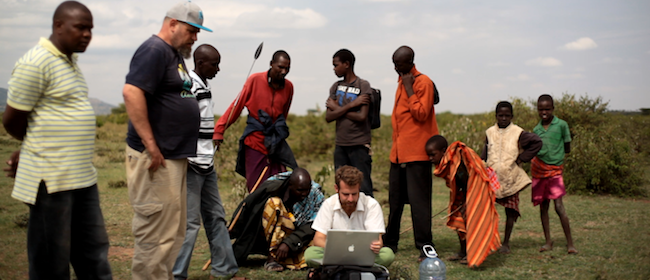Food Forest (Forest Gardens)
Forest gardening is a low-maintenance sustainable plant-based food production and agro-forestry system based on woodland ecosystems, incorporating fruit and nut trees, shrubs, herbs, vines, and perennial vegetables which have yields directly useful to humans. Making use of companion planting, these can be intermixed to grow in a succession of layers, to build a woodland habitat.
Forest gardening is a prehistoric method of securing food in tropical areas. In the 1960s, Robert Hart adapted the principles and applied them to temperate climates.
In Samburu County
Sadhana Forest Kenya hand-in-hand with the Samburu will plant in local shambas (family farms) a diverse range of trees, shrubs, and grasses that can be used to provide a more nutritionally diverse range of foods. Because the planting will take place within the shambas we can be sure that the young plants, the future forests of Samburu County, will be protected from animal grazing and human deforestation. The result is a diverse and healthy ecosystem and long-term food security for local populations.
Samburu Tribe
Samburu County is part of the arid and semi-arid lands (ASAL) of Kenya located in the north which is inhabited by the Samburu tribe. The ASAL is prone to harsh weather conditions which have made the Samburus vulnerable to natural disasters such as prolonged droughts. Models on climate change have showed that by the end of the 21st century the Samburu people will be more and more vulnerable to increases in temperature which impact: water availability, increasing unpredictable rainfall patterns, and prolonged and more frequent droughts.
Within the county, the type of dryland differs significantly with more than 75% of the land in Samburu County classified as ‘low-potential’ rangeland, receiving between 250 – 600 mm of rain annually. Only 140,900 hectares (7 % of the land area) is medium-to-high-potential land that is suitable for agricultural production receiving (600-900 mm) of rain per year. Moreover, only 6,000 hectares of this land is currently cultivated, growing wheat, barley, maize, beans, and green vegetables.
Perversely, as more land is put under conventional agricultural cultivation in the highland areas of Samburu, vegetation cover has been reducing and precious fertile soil has become increasingly vulnerable to erosion. An increasing population has led to increased demand for natural resources, such as timber, charcoal, and other fuelwood, to provide a key source of income particularly for poorer families. Vulnerable (agro) pastoralists have also been led to over-exploit remaining pasture while at the same time, traditional methods of livestock and rangeland management have been eroded with increasing settling of populations in ‘urban’ areas. For example, the increase of human and livestock populations and their concentration around ‘urban’ centers (Kisima or Maralal), where they have adopted a sedentary pattern of life, has not been followed with appropriate measures of conservation.
The Samburu have traditionally supported their livelihoods through the grazing of their animals on communal land. However, over 80% of food commodities (maize, beans, pulses, wheat) are now purchased from the market, with poorer households now purchasing the cheapest cereals (maize) to make up the bulk of their diet. Today, they only get a small amount of their food needs from their livestock as herd sizes have declined for the poorest families. All households rely on wild foods during the hunger period, with poorer households getting up to 25% of their food needs from wild foods during the dry seasons.
Within northern Kenya, there is a direct connection between areas of high food insecurity and high rates of malnutrition. However, the available evidence and data on trends suggest that provision of food aid has not solved the problem, and will not solve it alone. Instead, frequent and high morbidity rates (caused largely by lack of potable water and poor hygiene/sanitation practices) as well as poor food consumption are the most significant contributors.
We understand that current land management and foreign food aid have not solved the issues that the Samburu have recently faced. Sadhana Forest Kenya hopes to address many of these environmental and long-term food and nutrition security issues through food forestry, and reversal of environmental degradation through training and implementation in soil, water, and wind erosion control.


